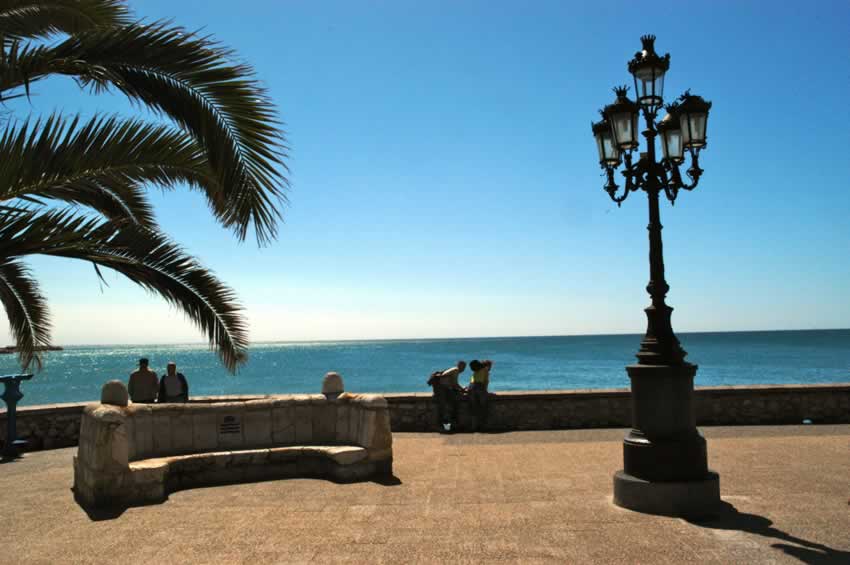
The itinerary through the old quarter begins at the Plaza del Ayuntamiento (the square in front of the town hall):
Ajuntament de Sitges (Town Hall), 1887-1889. Architect Salvador Vinyals Sabaté. Built on the site of the medieval castle, it is an example of civil architecture inspired by the Catalan Gothic style that flourished between the 13th and 15th century. The central body protrudes from the main building and is taller than the rest of the construction. It features a triple arched portico that recalls medieval market places.
Mercat Vell (Old Market), 1889. Architect Gaietà Buïgas. Plaça Ajuntament, 12. This purpose-built, single nave, market building was constructed in brick and is Modernista in style. The wrought iron awning over the entrance made the (currently named) Mercat Vell the first building in Sitges to incorporate a construction feature in this metal. The old market currently houses the visitor centre of Casa Bacardí.
Casa Miquel Utrillo, 1915. Architect Miquel Utrillo. Plaça Ajuntament, 15. An engineer by profession, Miquel Utrillo was passionate about art and culture. Writer, journalist, painter, art critic, Utrillo was not only highly renowned in Catalan artistic circles but elsewhere too, being awarded Chevalier de Legion d’Honneur et Officier de l’Académie Française and Honorary Member of the National Geography Society. Utrillo designed his own house taking inspiration from traditional Catalan architecture. The decoration around the windows using the sgraffito technique, show a Renaissance influence. The building is currently the Santiago Rusiñol Library.
Take Calle de la Davallada towards the Sant Sebastiá beach and look out for:
Casa O. Paget de Folch i Torres, 1935. Architect Josep Maria Martino Arroyo. Calle Davallada, 13. This private home is built in an Eclectic style. The stone frame of the main entrance and the even more impressive and intricate stone carvings around the central window are some of the many features inspired by different architectural styles that grace the façade. The roof is also worth mentioning.
On the left is Calle D’en Bosc. Number 10 is the Palau del Rei Moro (Palace of the Moor King), which dates back to the 14th century and was subsequently renovated in the 20th century after the Spanish civil war. It features a stone façade and an Arabic tile roof. A large semi-circular stone arch frames the front door. The first floor features two fine examples of double mullioned stone windows that together with the lintels and their pointed three-foiled arches indicate the building is medieval. There are various Gothic elements in the interior of the palace. The property was purchased by the town hall at the beginning of the 21st century. During Christmas, nativity dioramas are on display and during Easter the dioramas represent the Passion of Christ. The building hosts a number of cultural associations.
Back to Calle de la Davallada, the walk continues:
Casa Aleix Vidal Quadras, 1855. Architects: Francesc Cros Masó and Josep Cros Juliana. Davallada, 12-14. This mansion built in a Romantic style is a statement of the riches its owner made in America. Upon his return from overseas, Aleix Vidal Quadras built this large house a very short distance from the home of his brother Manuel Vidal Quadras (Calle Port Alegre, 9). The building, known as Edificio Miramar, is owned by the Diputación de Barcelona. Interesting exhibitions are programmed here on a regular basis. The house has a façade featuring stone pilasters and a large terrace with balustrade and sea view. Aleix Vidal Quadras is buried in the Sitges Cemetery in an individual tomb crowned by the Angel of Judgement, a sculpture by Enric Sagnier.
The home built by Manuel Vidal Quadras, brother of Aleix Vidal Quadras, is in front of the Playa Sant Sebastià.
Casa Manuel Vidal Quadras, 1852. Calle Port Alegre, 9. The owner of this property also traded in the Americas and made a fortune. This grand house is built in a Neoclassical and Romantic style and the façade features giant Corinthian pilasters. In front of the house there is a fenced monument built to Santiago Rusiñol.
Casa Conrad Subirà, 1920. Architect: Bernat Pijoan. Calle Port Alegre, 17. This charming seafront house features a white façade with blue detailing around the windows. The wooden eaves are also painted in the typical Sitges blue.
Casa Maria Montané, 1920. Architect: Benvingut Caballol Moreu. Calle Port Alegre, 45. The main features of this building are the single large window on the ground floor, a single window and a sgrafitto sundial on the first floor and the arched gallery on the second floor. The house is built in the Noucentisme style.
At the end of Playa Sant Sebastià where the Balmins promenade begins, we find the Chapel of Sant Sebastià, an eighteenth century construction modified at the end of the nineteenth century. It has a single nave with side chapels and a bell tower. The roof is covered with glazed ceramic tiles. The chapel is adjacent to the cemetery where there are numerous funerary sculptures. Having made their fortunes in Cuba, the “Americanos” wished to build pantheons and tombs to mirror their new economic status thus engaging the best artists of the time such as Josep Llimona, Josep Reynés, Pere Jou and Manuel Fuxà.
Turn left off Calle del Port Alegre (away from the sea), to reach Calle Joan Maragall (parallel to Calle Port Alegre), to find:
L’Escorxador, 1920. Architect: Josep M. Martino Arroyo. This building used to be the town abattoir. It has a white façade with exposed brick details on corners and around the three windows, which are built into the upper part of the central structure. The porch at the entrance features exposed brick columns and arches.
Retrace your steps and return to the beginning of the Playa Sant Sebastià and go up Calle Fonollar to see:
Cau Ferrat, 1893-1894. Architect Francesc Rogent i Pedrosa. Carrer Fonollar, 2-6. Artist Santiago Rusiñol acquired two fishermen’s houses and had them converted into the Cau Ferrat that would serve as both his studio and his home. The façade was given a Neogothic style emphasized by incorporating the Gothic windows of Sitges’ old castle. A grand gothic hall with wooden coffered and carved high ceilings takes up the whole of the first floor.
Palau Maricel, 1910. Architect: Miquel Utrillo. Calle Fonollar. A wealthy American businessman and art collector named Charles Deering commissioned the building of the Palau Maricel. It was built upon a group of fisherman’s houses on one side of the street and the medieval hospital of Sant Joan on the other. A portico bridge featuring a stone arch was built over the street to communicate both sides. The seaside building has a tower with battlements, Torre de Sant Miquel. The building on the land side (Maricel de Terra) has a staircase that leads to the Salón de Oro and from there to the Salón Azul. The building features a number of terraces decorated with artisan ceramic tiles with magnificent views over the Mediterranean. Sculptor Pere Jou crafted the window capitals.
As a fitting end to the itinerary around the old quarter you may wish to continue to the Plaça del Baluard, descend the steps of La Punta to arrive at the Plaza de la Fragata, a lovely area to enjoy some refreshments in one of the bars or restaurants facing the sea.








































